| 1 | Ashe’s spitting cobra |
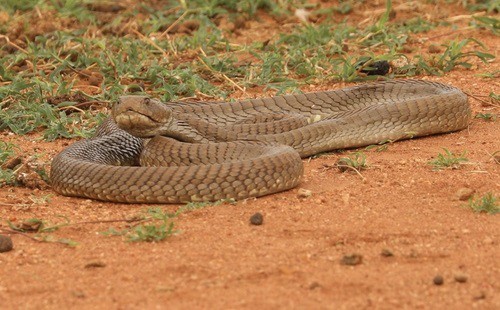
Perhaps the deadliest snake in Kenya, due to a deadly dance of airborne venom jets spat from holes in its fang tips, and the regular venom injected through a bite. Ashe’s spitting cobra was only made an official species in 2007, when it was split from the black-necked spitting cobra due to its blatant colour difference. This is the largest spitting cobra of all, at a maximum of 2.7 metres.
Naja ashei inhabits drier areas of eastern and northern Kenya, favouring semi-deserts, coastal thickets and dry savannah. They’re able to eat venomous snakes, including puff adders (Bitis arietans) and even their red spitting cobra (Naja pallida) cousin. White-throated savannah monitors are also confirmed prey. Ashe’s spitting cobras like to dash around the countryside in an overeager state, but they also like to shelter lazily, particularly in vacant underground burrows or termite mounds.
Mount Kasigau, Kenya is a confirmed zone for them, and bite symptoms include blistering, swelling, necrosis, and other local tissue damage. The venom contains an ingredient not found in other spitting cobras: cobra venom factor, comprising 0.12% of toxins. This inhabits complement C3 protein, thus weakening the body’s healthy inflammatory and immune responses. Otherwise, its venom is similar to other spitting cobras, containing 69% three finger toxins, and 27% PLA2s. Generally, spitting cobras are far less neurotoxic than other cobras, specialising in local destruction.
| 2 | Montane egg eater |
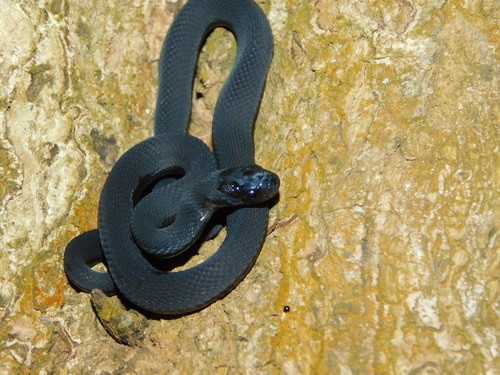
There are many Dasypeltis egg-eaters in Africa, but the montane egg eater (Dasypeltis atra) controls northern Tanzania, a chunk of Kenya, and Uganda. Montane egg-eaters are found above 1500 metres, in high altitude forests or savannah, up to altitudes of 2800 metres. This includes the hills near the capital Nairobi, located at 1795 meters above sea level. While they’re most concentrated in the high plateau of southwest Kenya, they’re also found in the Taita Hills of southeast Kenya, as discovered in 2015. Dasypeltis atra also appears on the forested slopes of Mount Kenya, though they’re not cunning and watchful defenders like the Mt Kenya bush viper.
Dasypeltis atra swallows both freshly laid eggs and those with half-matured embryos. They initially swallow eggs whole, with a bulge like a bowling ball moving down their throat. Then they writhe and flail around, cracking the shell with their sharpened vertebrae. The nutritious liquid spills into their belly, while the flattened and crushed shell is regurgitated.
This snake has many colour morphs. There’s car tyre black like above, sandy beige to disappear into bare soils, and brown overlaid with fine white markings. The eye colour follows the morph: black ones have black eyes, beige ones golden eyes, and reddish ones red-tinged eyes. Their pupil is vertical, though this is impossible to make out in black morphs. Dasypeltis atra is a nocturnal snake, which retreats to tree hollows and abandoned birds’ nests by day, which are well chosen for disguise. The inside of their mouth is a rich velvety black, which is the last thing an egg will ever see. Montane egg eaters often bare this black mouth wide to intimidate predators, while making repeated mock strikes. It’s all a ruse, as their teeth are way too tiny to inflict serious damage.
| 3 | Mount Kenya bush viper |
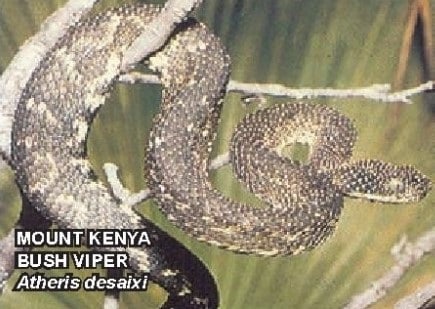
If you want to climb Mount Kenya, the country’s highest mountain, from the southeastern direction, then you must tiptoe past a deadly guardian: the Mount Kenya bush viper (Atheris desaixi). This is an extremely rare snake which clings to branches most of the day, in ambush posture, and reaches a maximum length of 70cm.
Atheris desaixi is confirmed in just two locations: the southeast flanks of Mount Kenya (altitude 5199 metres), and the Nyambeni mountain range just to the northeast. Mount Kenya bush vipers begin life as a plain yellow with a white tail tip. In adulthood, they develop grey-green scales each with pale edge, that create a spotted appearance.
Though armed with a destructive anticoagulant venom, which likely triggers haemorrhaging in victims (no detailed reports exist), Atheris desaixi has other defensive tricks to deploy. They often rub their keeled scales together to produce a loud sawing noise, like the saw-scaled viper of India. They at least try to give encroachers on their secluded forest slopes a warning. Captive keepers have noticed how they cease this nervous sawing as they grow comfortable in their terrarium. Mount Kenya bush vipers are one of Africa’s rarest venomous snakes, and are found exclusively in Kenya.
| 4 | Rukwa sand racer |
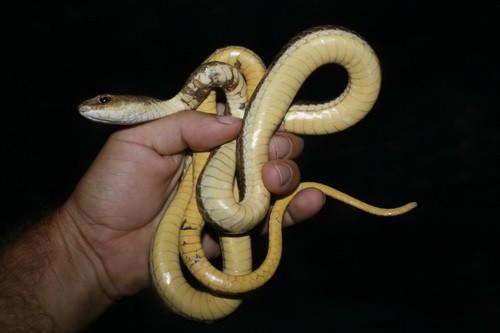
A rare snake, with only scattered records across eastern Africa. Its empire is large, spanning from southern Chad to Tanzania, with Kenya squarely in the middle, yet its confirmed locations often have hundreds of miles between them. Rukwa sand racers (Psammophis rukwae) are thin-bodied and reach a confirmed maximum so far of 147.8cm, discovered in Kafukola, Tanzania.
This is a fast and twitchy snake, which is believed to use its agility to chase down lizards across the majestic African flats, and wrestle them down its throat. Despite the name, Rukwa’s sand racer prefers habitats with some moisture rather than bone dry deserts, including flood plains, grasslands and savannahs.
Psammophis rukwae is always a brown and beige snake, with a couple of distinct morphs. One is plainer, while the other has darker, parallel stripes stretching down its body. A plain yellow belly is another ID sign. Its scales are smooth to touch, if you manage to outwit it with its rapid speed. Rukwa’s sand racer has round pupils, moves by day, and hunts mainly using its advanced eyesight. Of the 33 Psammophis members, this is one of the most poorly researched.
| 5 | Olive marsh snake |
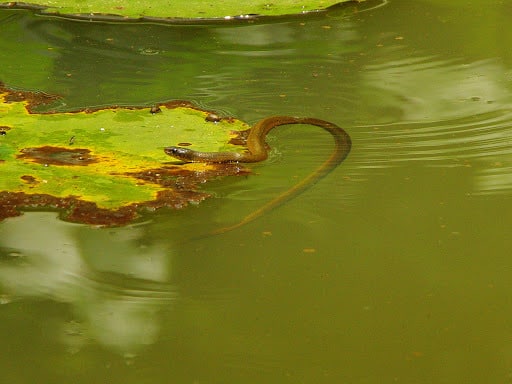
A harmless water-loving snake with round pupils, which is particularly common in southwest Kenya. The olive marsh snake inhabits rivers, lakes, swamps, and of course marshlands, usually within moist savannahs. Their territory is large, stretching from Ethiopia to Mozambique, but they won’t appear without sufficient water to duck, dive and swim around in. The exception is rainy season, when the increased water sloshing around the Kenyan countryside allows them to travel far and wide.
Frogs, tadpoles, small fish and frogs eggs are on the menu for this Kenyan snake. They appear from sea level to a maximum altitude of 2200 metres, and are known as Kaputi in northern Mozambique. Olive marsh snakes vary wildly in colour. Those near Mount Meru in Tanzania are bright green overlaid with a maroon stripe, while a handful from the Congo have been pure black.
Olive marsh snakes have a maximum recorded length of 60.0cm, and an average adult length of 35cm. If grabbed by the tail, they suddenly spin their body, in order to detach the tail, and escape by the skin of their teeth. 43.6% of Natriciteres olivacea had missing tails according to a 1987 survey. This is a placid species which rarely attempts to bite. They’re an egg-laying snake, with a range of 3-11.
| 6 | Sudanese sand snake |
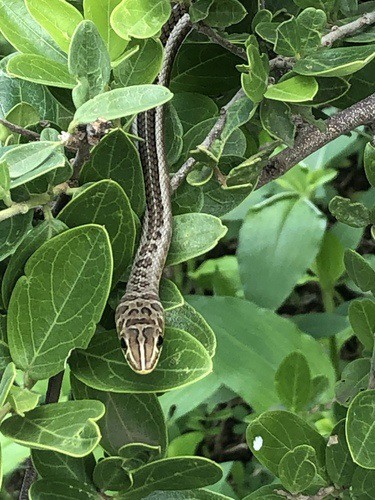
Another fast, whippy snake which charges down its prey and forces them down manually. Sudanese sand racers inhabit both moist and dry savannah, coastal thickets and high altitude grassland. They range from 0 to 2700 metres above sea level. They’re no threat to human beings and mainly inhabit western Kenya, zipping past lazy puff adders and weaving through the legs of zebras.
Psammophis sudanensis closely resembles the Rukwa sand racer, but is a fully distinct species. This time, nearly all individuals are adorned with parallel stripes running lengthways down their body, with stony grey contrasting against lighter grey and beige. The longest male Sudanese sand racer measured 121.0cm, while females are slightly longer, at an all-time species record of 132.5cm. Both were recorded in Torit, South Sudan.
The Sudanese sand snake is one of a few dozen species worldwide known to rub a strange secretion over its scales, using its nose, as though waxing itself. This is one of the serpent kingdom’s great mysteries, though one theory is that this substance prevents moisture loss, in baking arid environments.
Psammophis sudanensis mainly lives in eastern Africa, including Kenya and northern Tanzania. They can be very abundant in certain locations, as in a herpetological survey in Chad savannah, they were the single most common colubrid snake, making up 17% of 1010 colubrids collected. There’s also an outpost in western Africa, over a thousand miles away, where the species is far scarcer.
| 7 | Israeli catsnake |
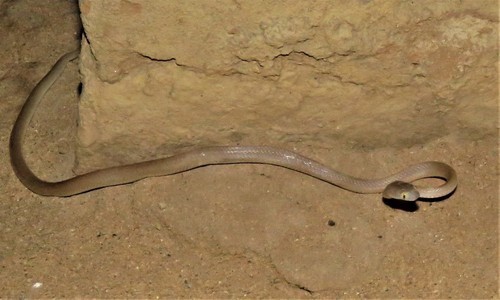
A species of parched and dry areas, rather than lush forests. This is a mildly venomous snake with a very thin body, but a large round head, resembling the handle of a whip. Telescopus dhara is a snake with a large, sprawling territory. Despite the name, Israeli catsnakes stretch from Oman and the UAE, through Egypt and Somalia and all the way to Kenya, which lies at the southernmost end of its territory. Unlike many of this list, Telescopus dhara is found only in the drier eastern and northern Kenya. Semi-desert and dry savannah are its heartlands.
Telescopus dhara is a thoughtful and deliberate snake, which never dashes around in a rush like Ashe’s spitting cobra. Israeli catsnakes are nocturnal, and retreat to the safety of dry rock cracks by day. They’re no cowards, and will rear up, hiss and strike at opponents if their comfortable danger threshold is exceeded. No human deaths are known, but few bite reports exist at all.
In East Africa, the record length of Telescopus dhara is 100cm, and the average 50-80cm. One of their confirmed prey is the Kenya rock agama (Agama lionotus).
| 8 | Red-spotted beaked snake |
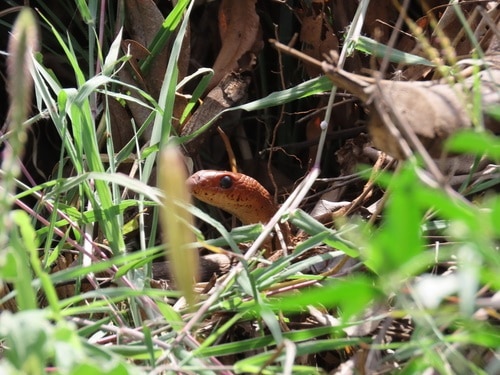
A snake of drier areas rather than forests, including semi-deserts and dry savannahs. This species occupies northern Tanzania, much of Kenya, and a swathe of Somalia. Red-spotted beaked snakes are especially common along the eastern Kenyan-Tanzanian border, lurking in coastal thickets and scrubland.
Rhamphiophis rubropunctatus is quietly one of east Africa’s larger snakes, reaching up to 240cm. The namesake red spots are mainly found in youths, or sometimes on its flanks, on the border between its pale ivory belly, and its redder body. This species should really be called the red-headed beaked snake; the redness suddenly gains intensity at the head, and this may be its most obvious ID sign. Otherwise, there are few patterns, just bright clean colours. Rhamphiophis rubropunctatus has round pupils, and a black tongue.
This is a venomous snake, secreting its toxin mixture from rear fangs. The exact chemical profile and lethality of the venom remains a mystery. They’re capable of spreading a small hood, mimicking a cobra. Rhamphiophis rubropunctatus is another species to rub its body with a strange waxy substance. Scientists even timed this rubbing behaviour and found it to last 154 seconds per average session.
| 9 | Tana Delta smooth snake |
A snake which has not been seen for 90 years. The Tana Delta smooth snake (Meizodon krameri) is known from just 2 specimens, discovered in 1934 near the Kenyan villages of Kau and Golbanti, in the Tana River Delta region. In 1985, these stored individuals were reanalysed and declared to be not Meizodon regularis, but an all new species. It differed by having fewer ventral (belly scales), and 26 maxillary teeth versus 23. The two 1934 snakes measured 32cm and 50cm.
Since 1985, there has been no update. The Tana Delta smooth snake may be extinct, but it’s more likely a master at flying under the radar. The Meizodon family is especially secretive. Semiornate snakes (Meizodon semiornatus) are widespread in Mozambique and South Africa, yet are rarely encountered by villagers, such is their liking for cover objects like logs, rotting leaves, stones and overgrown vegetation near streams.
Meizodon members are uncomfortable when exposed, and this is why the Tana Delta smooth snake remains hidden till this day. Bookmark this snake in your mind for a future “lost snake rediscovered” media frenzy, so that you can smugly inform your friends that you’ve already heard of it.
| 10 | Battersby’s green snake |
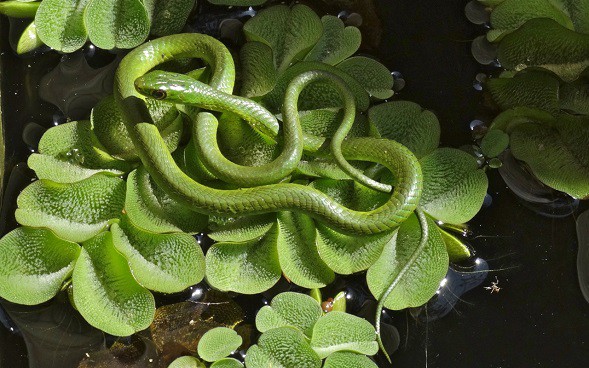
A water-loving species, which is abundant around the capital of Nairobi. Battersby’s green snake is a pure green with no patterns, varying from duller light green to full grassy green like above. Spotting one is a hopeless task when in the middle of juicy reeds, water-lillies and thick riverside vegetation. There is a small white base to each scale, but this is only visible when they inflate their body as a defensive warning.
Battersbyi’s green snake is a climbing species, but is almost always found in bushes or trees close to a water body. They also have the power to hunt underwater. There’s no dangerous venom, but Battersbyi’s green snake has sharp teeth and knows how to use them. When biting, they wrestle their head from side to side to create deeper and more extensive lacerations.
This snake reaches a maximum of 90cm, and large bulbous eyes are one memorable feature. They’re also common in Rubondo Island National Park, in Lake Victoria in far northern Tanzania. This is a close relative of South Africa’s green watersnake (Philthamnus hoplogaster), but that snake has a higher number of ventral (belly) scales than P. battersbyi.
